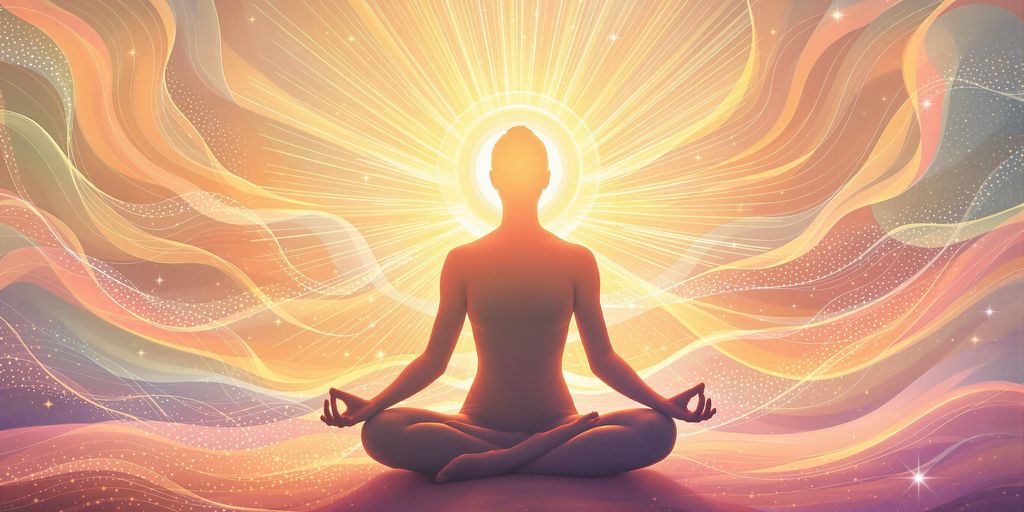
Unlocking the Energy Within: Exploring the Connection Between Kundalini and Yoga
Kundalini and yoga are often talked about together, but what do they really mean? Kundalini is believed to be a dormant energy at the base of your spine, and yoga is one of the ways people try to wake it up. This ancient practice has deep roots in spiritual traditions but is also gaining popularity today for its mental and physical benefits. Let’s break it all down and explore how these two concepts connect.
Key Takeaways
- Kundalini is described as a coiled energy at the base of the spine, and yoga helps activate it.
- The practice combines physical postures, breathwork, and meditation to move energy through the chakras.
- Kundalini yoga is different from other yoga styles, focusing more on energy and awareness than physical poses.
- Many people report spiritual growth and emotional balance as benefits of Kundalini yoga.
- It’s important to approach Kundalini yoga safely, especially if you’re new to the practice.
The Essence of Kundalini and Yoga

Understanding Kundalini Energy
Kundalini energy is often described as a dormant force coiled at the base of the spine, waiting to be awakened. This energy is not just a mystical idea but a profound concept rooted in ancient Indian traditions. When activated, it travels upward through the chakras, or energy centers, along the spine. This journey is believed to lead to heightened states of awareness, inner clarity, and even spiritual enlightenment.
Think of it this way: Kundalini energy is like a reservoir of untapped potential within you. Activating it isn’t about following rigid rules but about connecting with yourself on a deeper level. This energy doesn’t just stay in the realm of the spiritual; it also impacts your mental and physical state, creating a holistic sense of well-being.
The Role of Yoga in Awakening Kundalini
Yoga, particularly Kundalini Yoga, is a key practice for awakening this energy. Unlike other styles like Hatha or Vinyasa, Kundalini Yoga focuses less on perfecting poses and more on integrating breathwork, chanting, and meditation. These elements work together to stimulate the flow of Kundalini energy, helping it rise through the body.
Here’s how yoga supports this process:
- Breathwork (Pranayama): Techniques like alternate nostril breathing help balance the energy flow.
- Meditation and Chanting: These practices calm the mind and create a focused environment for energy activation.
- Dynamic Movements (Kriyas): Specific sequences are designed to target energy blockages and enhance vitality.
Spiritual and Physical Dimensions of the Practice
Kundalini Yoga isn’t just about spiritual growth; it’s equally about physical and emotional health. The practice strengthens your body, sharpens your mind, and opens the door to self-discovery.
- Physical Benefits: Improved flexibility, better posture, and increased energy levels.
- Mental Benefits: Enhanced focus, reduced stress, and emotional stability.
- Spiritual Growth: A sense of connection with your higher self and the universe.
At its core, Kundalini Yoga is about balance—between the physical and the spiritual, the mind and the body, and the individual and the universe.
If you’re considering starting your journey, having the right tools is essential. For example, using a high-quality yoga mat like the Dora Szentmihalyi Jungle Yoga Mat can make your practice more comfortable and enjoyable. It’s a small step that sets the foundation for a transformative experience.
The Journey of Kundalini Through the Chakras
Exploring the Seven Chakras
Kundalini energy is often described as a coiled force resting at the base of the spine, waiting to rise. As it ascends, it moves through the seven chakras, or energy centers, each representing a unique aspect of human experience. Here's a quick breakdown of these chakras:
- Root Chakra (Muladhara): Tied to survival and grounding.
- Sacral Chakra (Svadhisthana): Governs emotions and creativity.
- Solar Plexus Chakra (Manipura): Associated with personal power.
- Heart Chakra (Anahata): Represents love and compassion.
- Throat Chakra (Vishuddha): Linked to communication and expression.
- Third Eye Chakra (Ajna): Focuses on intuition and insight.
- Crown Chakra (Sahasrara): A gateway to spiritual connection.
Each chakra acts as a gate, and the energy must pass through these to rise fully.
How Kundalini Energy Moves Through the Body
When awakened, Kundalini energy flows upward along the spine, following a channel called the "Sushumna Nadi." This journey isn't just physical—it's deeply tied to emotional and spiritual growth. The energy purifies and activates each chakra, unlocking new levels of awareness. Think of it as peeling back layers of yourself to find clarity and balance.
The process isn't always linear. Sometimes, energy might feel "stuck" at a particular chakra, signaling areas where personal growth or healing is needed.
The Connection Between Chakras and Consciousness
The chakras aren't just energy hubs—they're reflections of your state of mind. For example:
- A blocked Root Chakra might make you feel insecure or disconnected.
- An overactive Heart Chakra could lead to overwhelming emotions.
- A balanced Third Eye Chakra fosters clear thinking and intuition.
As Kundalini rises, it harmonizes these centers, creating a sense of unity between body, mind, and spirit. This alignment is often described as a path to higher consciousness or enlightenment.
Awakening Kundalini energy is less about forcing change and more about allowing your natural energy to flow freely. Patience and self-awareness are key to this transformative journey.
For more about how Kundalini energy activates each chakra, check out Kundalini awakening.
Core Practices in Kundalini Yoga

The Power of Kriyas and Sequences
Kriyas are the backbone of Kundalini Yoga. These are structured sets of movements, postures, and breathing techniques designed to achieve specific goals. For instance, one kriya might focus on boosting your energy levels, while another may aim to calm your mind. Each kriya is like a recipe, carefully crafted to activate certain energy pathways in the body.
Here’s how a typical kriya might unfold:
- Start with a warm-up, such as gentle stretches or spinal rolls.
- Move into the kriya sequence, which can include dynamic movements or static poses.
- Conclude with a relaxation phase to allow the body to absorb the benefits.
The beauty of kriyas is their versatility. Whether you’re seeking mental clarity or physical strength, there’s likely a kriya tailored to your needs.
Breathwork Techniques for Energy Activation
Breathwork, or pranayama, is a cornerstone of Kundalini Yoga. The way you breathe can significantly influence your energy and mental state. Common techniques include:
- Breath of Fire: A rapid, rhythmic breathing pattern to energize and detoxify.
- Long, deep breathing to calm the mind and body.
- Alternate nostril breathing for balancing energy channels.
Focusing on your breath isn’t just about oxygen—it’s about directing life force energy, or prana, throughout your body. Over time, these practices can help you feel more centered and aware.
The Role of Meditation and Mantras
Meditation in Kundalini Yoga is more than just sitting quietly. It often involves chanting mantras, using mudras (hand positions), or focusing on specific visualizations. The mantra "Sat Nam," meaning "truth is my identity," is a common one, repeated to reinforce self-awareness.
Here’s a simple meditation you can try:
- Sit comfortably with your spine straight.
- Close your eyes and focus on your breath.
- Chant "Sat Nam" silently or aloud with each inhale and exhale.
- Continue for 3-11 minutes, increasing the time as you feel comfortable.
Meditation and mantra work together to quiet the mind, making space for deeper insights and emotional balance.
Incorporating these practices into your routine can be transformative. Whether you’re drawn to the physical intensity of kriyas, the energetic shifts of breathwork, or the mental clarity of meditation, Kundalini Yoga offers tools to explore your inner potential.
The Transformative Benefits of Kundalini Yoga
Physical and Mental Health Improvements
Kundalini Yoga is more than just a workout; it’s a holistic approach to well-being. Physically, it strengthens the nervous system, enhances flexibility, and improves circulation through specific kriyas and breathwork. Mentally, it sharpens focus and reduces stress. The unique combination of movement, breath, and meditation helps regulate the body’s energy systems, creating a sense of balance and vitality.
Spiritual Growth and Self-Discovery
For those seeking a deeper connection to themselves, Kundalini Yoga offers an opportunity to explore their inner world. The practice awakens dormant energy at the base of the spine, guiding it upward through the chakras. This journey often leads to heightened spiritual awareness and a profound sense of purpose. Many practitioners describe it as a path to self-discovery, where they feel more in tune with their true essence.
Enhanced Emotional Resilience
Life throws curveballs, and Kundalini Yoga equips you to handle them with grace. The practice strengthens emotional resilience by teaching you how to manage stress and process emotions. Techniques like mantra chanting and controlled breathing help release pent-up emotions, leaving you feeling lighter and more balanced. Over time, you’ll find it easier to navigate life’s ups and downs without being overwhelmed.
The Historical Roots of Kundalini Yoga
Origins in Ancient Indian Traditions
Kundalini Yoga has its beginnings in ancient Indian spirituality, with references dating back over 5,000 years to the Indus Valley Civilization. The term "Kundalini" comes from the Sanskrit word meaning "coiled," symbolizing the dormant energy said to rest at the base of the spine. This concept was first explored in sacred texts like the Upanishads and later expanded upon in the Hatha Yoga Pradipika. Early practitioners viewed the awakening of Kundalini energy as a path to deeper self-awareness and spiritual enlightenment.
The Influence of Yogi Bhajan
In the late 1960s, Yogi Bhajan brought Kundalini Yoga to the West, forever changing its trajectory. He introduced structured practices that combined breathwork, meditation, and physical postures, making the practice accessible to a broader audience. Yogi Bhajan emphasized that Kundalini Yoga was not just a physical exercise but a holistic approach to life, focusing on balancing the mind, body, and spirit. His teachings continue to influence modern yoga communities worldwide.
Evolution of Kundalini Yoga in the West
Since its introduction, Kundalini Yoga has evolved significantly. It has grown from a niche spiritual practice to a popular form of yoga embraced by people from all walks of life. Today, it is celebrated for its unique blend of physical, mental, and spiritual elements. Many practitioners incorporate tools like the Pagoda Yoga Mat to enhance their experience, combining traditional techniques with modern conveniences. This fusion of ancient wisdom and contemporary practice has cemented Kundalini Yoga's place in the global wellness landscape.
Kundalini Yoga serves as a bridge between ancient spiritual traditions and modern lifestyles, offering a path to both personal growth and collective well-being.
Common Misconceptions About Kundalini and Yoga
Debunking Myths About Kundalini Awakening
One of the biggest misconceptions about Kundalini awakening is that it’s dangerous or uncontrollable. People often hear dramatic stories about overwhelming energy or sudden, life-altering changes. The truth is, Kundalini awakening is a gradual process for most people, and it unfolds in stages. It’s not a chaotic event but rather a progressive journey of self-awareness and spiritual growth.
Another myth is that Kundalini awakening only happens to advanced yogis or spiritual masters. In reality, anyone can experience this energy shift through consistent practice, mindfulness, and patience. It’s not reserved for an elite few.
Understanding the Safety of the Practice
Some believe that practicing Kundalini Yoga is inherently risky. While it’s true that this form of yoga involves powerful techniques like breathwork and kriyas, it’s not dangerous when approached with care. Here are some tips to ensure safety:
- Start with beginner-friendly classes or routines to build a solid foundation.
- Listen to your body and avoid pushing yourself into discomfort.
- Work with a qualified teacher who can guide you through the practice responsibly.
By following these steps, Kundalini Yoga can be a safe and enriching experience.
Separating Fact from Fiction
There’s also confusion about what Kundalini energy actually is. Some view it as mystical or even supernatural, but it’s more helpful to think of it as a natural part of human energy. It’s described as a coiled energy at the base of the spine, waiting to be activated. The practice of Kundalini Yoga simply helps to channel this energy through the body’s chakras, leading to better balance and awareness.
Another common misconception is that Kundalini Yoga is only about spiritual awakening. While that’s a significant aspect, it also offers practical benefits, like improved focus, emotional resilience, and physical vitality. It’s a holistic practice that goes beyond just the mystical elements.
Kundalini Yoga isn’t about chasing extraordinary experiences; it’s about embracing your own energy and using it to live a more balanced, conscious life.
For example, common symptoms of Kundalini awakening like spontaneous kriyas or energy shifts are not signs of something going wrong. They’re natural indicators of progress, as long as they’re experienced in a safe and guided environment.
Integrating Kundalini Yoga Into Daily Life
Creating a Personal Practice Routine
Building a Kundalini Yoga routine doesn’t have to be complicated. Start small, even just ten minutes a day, and gradually increase your time as you get more comfortable. Consistency matters more than duration, so aim to practice at the same time daily. Mornings are ideal for energizing practices, while evenings can help you unwind. Here’s a simple way to structure your session:
- Tuning In: Begin with the mantra "Ong Namo Guru Dev Namo" to set your intention.
- Warm-Up: Do light stretches or neck rolls to prepare your body.
- Kriya or Sequence: Choose a kriya that aligns with your goals, like stress relief or boosting energy.
- Meditation: Spend a few minutes in quiet contemplation or chant a mantra.
- Closing: Seal the session with the "Long Time Sun" song or a simple "Sat Nam."
Balancing Kundalini Yoga with Modern Lifestyles
Life can be hectic, but Kundalini Yoga can fit into even the busiest schedule. If you’re short on time, focus on quick breathwork exercises or a short meditation. Here are some tips to make it work:
- Keep Your Gear Handy: Store your yoga mat and comfortable clothes in a spot where they’re easy to grab.
- Set Reminders: Use your phone to remind you to practice, especially when you’re starting out.
- Combine Practices: Pair Kundalini Yoga with other self-care routines, like journaling or morning coffee.
Tips for Beginners to Start Safely
If you’re new to Kundalini Yoga, it’s important to ease in to avoid feeling overwhelmed. Here’s how:
- Start Slow: Begin with gentle kriyas and avoid advanced techniques until you’re ready.
- Listen to Your Body: If something feels uncomfortable, modify or skip it.
- Stay Hydrated: Drink water before and after your practice to support your body.
Kundalini Yoga is more than a physical activity—it’s a way to connect with yourself on a deeper level. By starting small and staying consistent, you can bring its transformative benefits into your everyday life.
Wrapping It Up
So, that's the gist of it. Kundalini and yoga are like two sides of the same coin—both aiming to help you connect with yourself on a deeper level. Whether you're drawn to the physical poses, the breathing techniques, or the spiritual side of things, there's something in it for everyone. It's not about doing it perfectly; it's about showing up and seeing where the journey takes you. Who knows? You might just surprise yourself with what you discover.
Frequently Asked Questions
What is Kundalini energy?
Kundalini energy is often described as a coiled-up energy at the base of the spine. It's believed to be a source of spiritual power and potential that can be awakened through practices like yoga and meditation.
How does Kundalini Yoga differ from other types of yoga?
Unlike other forms of yoga that focus mainly on physical poses, Kundalini Yoga combines breathwork, meditation, chanting, and specific movements to awaken inner energy and promote spiritual growth.
Is Kundalini Yoga safe for beginners?
Yes, Kundalini Yoga can be safe for beginners when practiced under the guidance of a qualified teacher. It's important to start slowly and listen to your body to avoid feeling overwhelmed.
What are the benefits of practicing Kundalini Yoga?
Kundalini Yoga can improve mental clarity, emotional balance, physical health, and spiritual awareness. Many practitioners also report feeling more connected to themselves and the world around them.
Do I need special equipment to practice Kundalini Yoga?
No special equipment is needed. A yoga mat, comfortable clothing, and a quiet space are usually enough to get started with Kundalini Yoga.
Can anyone experience a Kundalini awakening?
Yes, anyone can experience a Kundalini awakening, but it often requires regular practice and dedication. The process is unique for each individual and unfolds at its own pace.

